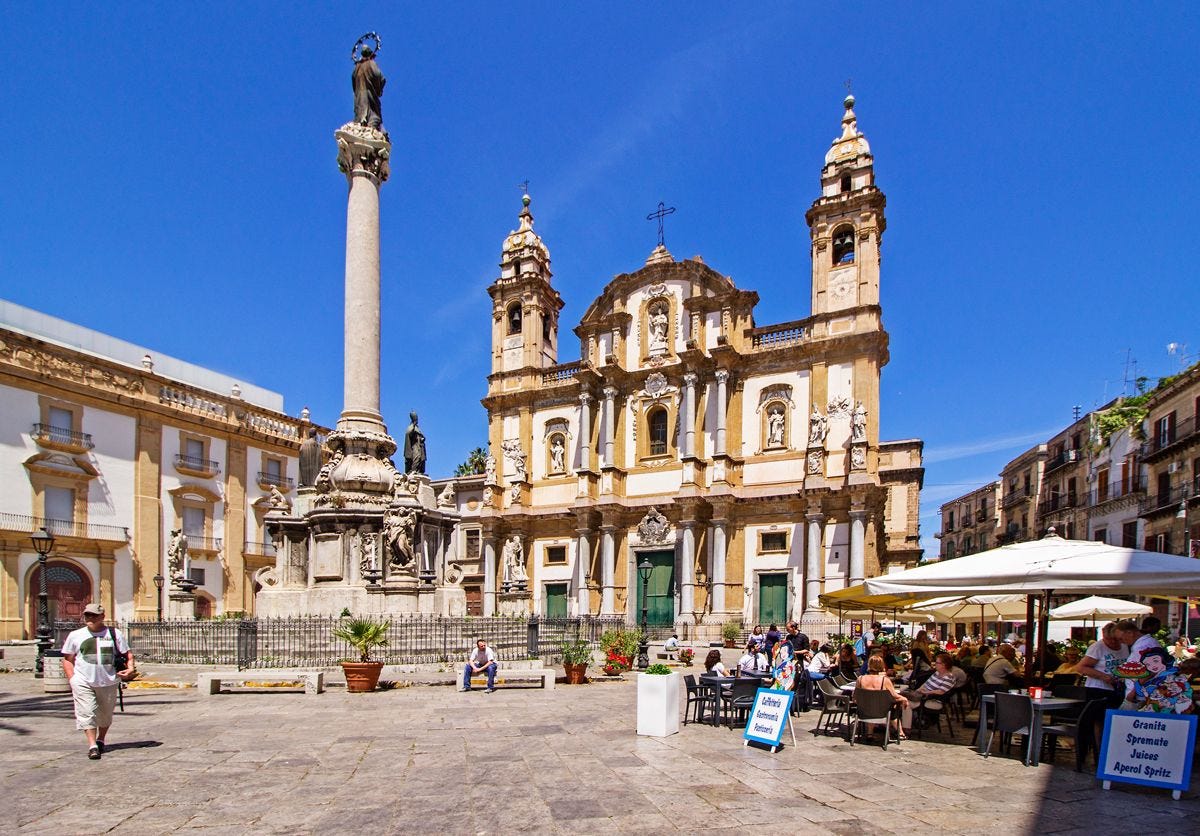Sicily is the biggest island in the Mediterranean. It has an extent of just under ten thousand square miles, and a population of just under five million. This makes for a population density of 500 people per square mile. That is actually not very much: England’s population is more than twice that density. Moreover, the Sicilian population is not evenly spread. There are big cities, big towns as well, but areas that are relatively empty, especially in the mountains. While Palermo and Catania are bustling, you can drive through the centre of Sicily and think of it as the island’s desolate heart. And you would be right. There is something almost frightening and threatening about the drive, for example, across the island from Agrigento to Palermo, passing through the province of Caltanisetta. The reason is that the centre of the island is very different in feel to the coasts. Most Sicilian life seems to be concentrated on the coasts. The centre is another matter entirely. It is rugged, dark, a land abandoned by its inhabitants, and a place once overrun with bandits. You do not feel secure there. It's atmospheric, but not in a good sense.
Consider the town of Mussomeli. This is a place that few visit, and it is midway between Agrigento and Palermo, high above the valley of the Platani river. One reaches it by a nerve-wracking zigzag road, if coming from Agrigento. (There is a better road on the Palermo side, not that I knew it at the time.) There are just under 10,000 inhabitants, and the town is perched at a height of 765 metres. From the town, which is as picturesque as any in Tuscany, you have a fine view of a ruined medieval castle, known as the Castello Manfredonico, which dates from the 14th century and sits atop a crag looking very sinister. In the town there is a church dedicated to the Madonna dei Miracoli, to whom there is a great local devotion. On my arrival at Mussomeli some years ago, I found myself caught up in a religious procession of the Blessed Sacrament, in which most of the town had come out to participate. It was highly devotional, a simply wonderful way to enter the place.
There are very few places to stay in Mussomeli, and very few places to eat; there is by no means a restaurant on every corner, and finding a place for lunch was quite hard. In stark contrast to a place like Taormina, Mussomeli, nice as it is, does not invite the traveller to linger.
Its native sons and daughters have, in large numbers, left. As is common with patterns of Italian emigration, people from Mussomeli and the surrounding towns of Sotera and Rivafreddo have opted to move to Woking in Surrey where there is a large expatriate community, and where, once a year, they celebrate the feast of the Madonna dei Miracoli with a procession. Part of the reason for this is because there are few jobs in Mussomeli. Once many were employed in agriculture. Now, with mechanisation, those sorts of jobs are no longer plentiful.
This is the real Sicily, the place people leave, only to return for summer holidays. The population of Mussomeli peaked at over 15,000 in the early 1950s. Since then it has lost a third of its inhabitants. That is astonishing, and it is also tangible; I realise this is subjective, but in the interior of Sicily you sense the desperation of the inhabitants to escape. And not just there. Years previously, on holiday in Trapani, youngsters would say to me ‘I want to live in your country.’ This surprised me, until I realised they thought I was American.
This subjective feeling gives rise to a fictional landscape (and there’s nothing more subjective than fiction) where the characters feel trapped, hemmed in, and long to escape. Their environment is suffocating and claustrophobic. Beautiful as the island it, one can sense the terror it breeds. Some of that terror has stayed with me.
Years ago, as a mere twenty-something, I was in Palermo; in those days every fountain in the city was broken, and there were very few bars and places to eat. Something extraordinary happened. At 5pm on a summer afternoon, I was near San Domenico, on the via Roma, and I suddenly realised that I was quite alone. A moment previously there had been people, but now all the shops were shut, and the streets were deserted. I walked back to the station to get my bus along empty threatening streets. It was broad daylight, but I have never been more frightened in my life.
Years later, I once got off the train at Catania Centrale and trundled my suitcase toward the centre of the city, to where I was staying just off the via Etnea, the principle street. It was no great distance, and I decided not to wait for a bus or get a taxi. One walked along streets that one hardly thought still existed. Filth, decay, collapsing buildings, and curious women with ruined faces studying one intently, all at about three in the afternoon. One had discovered, in the midst of a beautiful city, a place of desperation. Years later, the whole history of the Purgatory quarter of Catania came to me, for it was at that moment that the seed was planted.
The Purgatory quarter is of course fictional, but the things that happen there, are, I hope, based on reality. Very soon I will let the reader judge.





